As most people dealing with debt know, there are many different kinds of debt and some types are more difficult to eliminate in bankruptcy than others. Student loan debt is one such debt that’s not automatically discharged in bankruptcy proceedings. Unfortunately, this fact has led many people to believe that student loans can’t be discharged at all. Many borrower can discharge student loan debt through bankruptcy, but it requires additional steps.
This post explains how to file an adversary proceeding for student debt bankruptcy in Oregon, and help you decide whether it’s the right move for you.
How Do You File an Adversary Complaint for Student Loan Bankruptcy?
Getting student debt discharged through bankruptcy requires filing for an adversary proceeding. An adversary proceeding is a legal action that occurs within a bankruptcy case; it’s a formal process used to address specific issues or disputes between various parties that cannot be resolved through the regular bankruptcy process.
What are the Steps to Getting Student Debt Discharged through Bankruptcy?
The first step should always be consulting with an experienced bankruptcy attorney. Bankruptcy laws are extremely intricate, and this process is no exception. Need help finding a student loan lawyer? Check out our blog on how to hire the best student loan lawyer for you.
If you and your bankruptcy attorney believe your case meets the criteria, you should proceed with these steps:
- File the complaint: The complaint is filed with the bankruptcy court overseeing your case. There are specific forms and procedures you need to follow, which your attorney will be familiar with. Filing the complaint initiates the adversary proceeding and sets the legal process in motion.
- Serving the parties involved: After filing the complaint, it must be properly served to all relevant parties, including the student loan lender or servicer. This ensures that everyone involved is aware of the legal action and can respond accordingly.
- Responses and negotiations: The opposing party will respond to your complaint. This usually leads to negotiations or settlement discussions. Your attorney will guide you through these interactions and help you make informed decisions about potential resolutions.
- Court proceedings: Depending on the progress of your adversary proceeding, you might need to attend a deposition and trial. Your attorney will represent your interests and present your case to the judge.
- Decision rendered: The judge will ultimately make the decision. If the court rules in your favor, your student loans will be fully discharged. The judge can also order a partial discharge if it appears you can pay back some but not all of your student loans.
How Do They Decide Whether to Discharge Your Student Debt?
The judge will make a decision based on your specific situation. The decision is based on three main guidelines:
- Are you unable to maintain a minimal standard of living for you and your dependents? This is determined by current income and expenses.
- Is there a likelihood you will be able to pay back your loans in the future? Factors the judge will consider include disabilities, long-term unemployment, and other adverse circumstances.
- Have you made a good faith effort to repay your loan up until this point? If you’ve enrolled in an income-driven repayment plan, applied for forbearance or forgiveness programs, or consolidation, this can be used as evidence that you have made a good faith effort to pay.
Are You a Candidate for Student Loan Debt Discharge through Bankruptcy?
If student debt is crushing your ability to become financially independent, you may be a good candidate for student debt forgiveness. Of course, as with any possible legal strategy, it’s vitally important to get an opinion from a lawyer with specialized knowledge – in this case, an experienced bankruptcy attorney. An lawyer who focuses his practice on bankruptcy issues will understand the ins and outs of this particular area of law and can review with you some important considerations before you move forward.
While discharging student loans through bankruptcy is not guaranteed, taking the right steps and seeking professional guidance can increase your chances of achieving a favorable outcome and gaining relief from your student loan debt. If you’re ready to start exploring your options for filing an adversary complaint for student loan bankruptcy, give us a call today. Our experienced Oregon-based bankruptcy attorneys are ready to answer all your questions.

